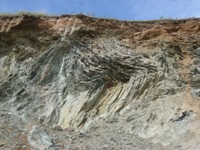Special Program for International Students
GRADUATE COURSE IN EARTH SCIENCE
& GEOENVIRONMENTAL SCIENCE
Current MEXT students
Li Weimin (China)
Email: Weimin_L2003 @yahoo.com
Thesis title: Geodynamic evolution of the Jiamusi Massif after separation from the Gondwana Super Continent: Jurassic accretion tectonics in the NE margin of the Eurasia continent.
Supervisor: Prof Akira Takasu (2008-2011).
The Jiamusi Massif is located in the eastern part of the Central Asian Orogenic Belt, which lies between the Siberian and Sino-Korean cratons (Sengör et al., 1993). The Jiamusi Massif is composed of the Mashan Complex, the Heilongjiang Complex, and Paleozoic granitic intrusions. The adjacent Songnen Massif consists mainly of granitic and dioritic basement, and consists of Middle Jurassic granitic intrusions and Early Jurassic to Neogene sedimentary cover. It is located to the west of the Jiamusi Massif, with the two massifs being separated by the Mudanjiang fault.
The Mashan Complex consists of upper amphibolite to granulite facies metamorphic rocks, and has been regarded as the basement of the Jiamusi Massif. Recent SHRIMP U/Pb dating of the metamorphic zircons suggests that metamorphism of the Mashan Complex took place at ca. 500 Ma. The metamorphic age is correlative with the Late Pan-African event in the Gondwana supercontinent (e.g. Wilde et al., 2000, 2003; Wu et al., 2007).
The Heilongjiang complex is mainly exposed in three areas, i.e. in the Luobei area in the north, in the Yilan area in the central part of the massif, and in the Mudanjiang area in the south (Cao et al., 1992; HBGMR, 1993). It consists predominately of alternations of blueschists and pelitic schists with intercalations of thin quartzite layers and marbles, along with ultramafic bodies. These constituents of the Heilongjiang Complex are thought to have been metamorphosed in a subduction zone between the Jiamusi and Songnen massifs (Cao et al., 1992; Zhang, 1992; Ye et al., 1994a; Wu et al., 2007). Recently, 40Ar/39Ar ages between 165 and 175 Ma from mica schists in the Heilongjiang complex suggest that it was accreted in the Early Jurassic. From this, it is probable that the Jiamusi Massif was part of the Gondwana super continent that was affected by the late Pan-African orogenesis, and that it drifted to the north and collided with the Asian continental margin during Jurassic times, as indicated by the blueschist facies metamorphism of the intervening Heilongjiang complex.
Significance of the research
The Heilongjiang complex is a typical accretionary complex in the Jiamusi Massif, of which it forms part. The evolution of the Jiamusi Massif, including the drift and collision to the eastern Eurasian continent after separation from the Gondwana supercontinent can be recorded within it. Based on petrographic and geochronological study of the Heilongjiang complex during the Ph.D course, I aim to explore the evolutionary history of the Heilongjiang complex, as well as the Jiamusi Massif and wider eastern Eurasia.
The specific aims of my research are:
- 1) To determine the metamorphic conditions and evolution of the high P/T metamorphic rocks in the Heilongjiang complex;
- 2) To determine the age of the high P/T metamorphic event in the Heilongjiang complex;
- 3) To reconstruct the tectonic evolution of the Jiamusi Massif;
- 4) To constrain the evolutionary history of eastern Eurasia.


